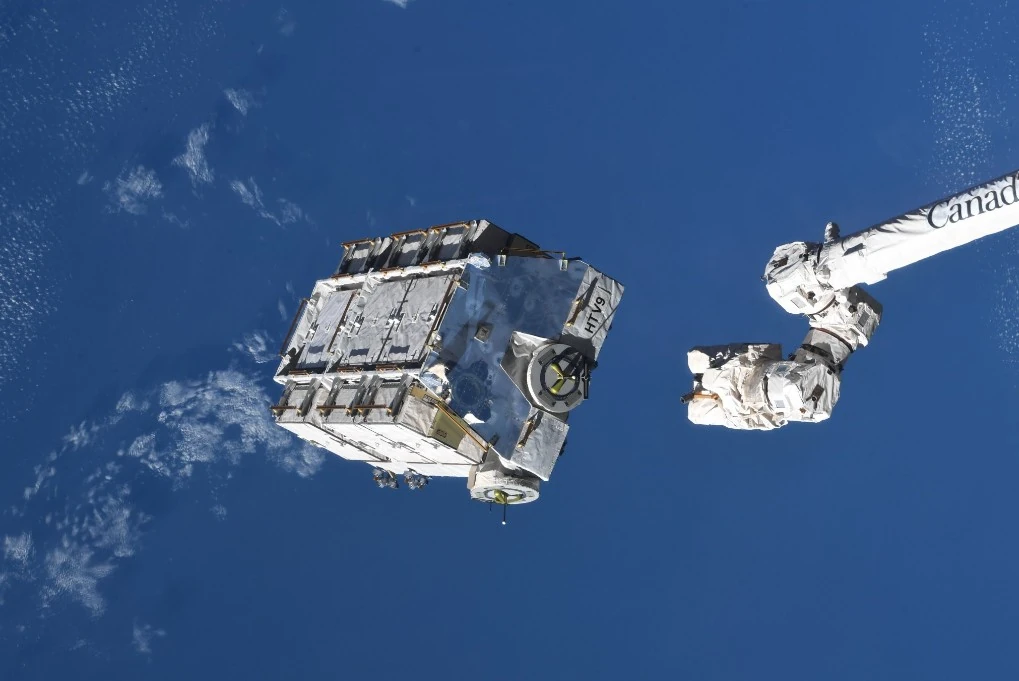The International Space Station’s (ISS) largest-ever discarded object, a hefty equipment pallet weighing 2.9 tons, is anticipated to make an uncontrolled descent back to Earth between March 8 and 9, 2024. Launched into space for a critical ISS power system upgrade, this pallet, loaded with nine old station batteries, will not fully disintegrate upon re-entry, with predictions indicating about half a ton of debris could survive the descent and impact the planet’s surface.
The International Space Station’s most massive object ever released—a 2 633 kg (5 800 pounds) equipment pallet—is expected to make an uncontrolled re-entry into Earth’s atmosphere this week.
According to official statements, the re-entry window is estimated between 12:30 UTC on March 8 and 08:30 UTC on March 9, 2024. Approximately 500 kg (1 100 pounds) of fragments are likely to impact the Earth’s surface.
Reentry of the EP-9 battery pallet jettisoned from ISS in 2021 is currently predicted (by Space Force) between 1230 UTC Mar 8 and 0830 UTC Mar 9. It will not totally burn up on reentry – about half a tonne of fragments will likely hit the Earth’s surface.
— Jonathan McDowell (@planet4589) March 7, 2024
The pallet, dispatched into the void by the station’s robotic arm, Canadarm-2, on March 11, 2021, was initially brought to the ISS by Japan’s HTV9 cargo ship in May 2020. Its mission was to assist astronauts in swapping out the station’s older nickel-hydrogen batteries for new, more efficient lithium-ion ones.
This equipment played a vital role in a series of operations that saw 48 old batteries replaced with 24 new ones across six years, involving four supply missions from the Japanese H-II Transfer Vehicle (HTV) cargo spacecraft, 13 astronauts, and 14 spacewalks.
“It was the largest object—mass-wise—ever jettisoned from the International Space Station,” NASA spokesperson Leah Cheshier said in March 2021. This jettison surpasses the previous record held by the Early Ammonia Servicing System tank released during the STS-118 mission in 2007.

The decision to dispose of the pallet in an uncontrolled manner was not part of the original mission plan. It resulted from logistical challenges and a backlog in equipment disposal caused by the failed launch of a Soyuz rocket in 2018.
This incident, which forced an emergency landing for NASA astronaut Nick Hague and Roscosmos cosmonaut Alexey Ovchinin, disrupted the schedule for spacewalks and subsequent equipment disposal. Typically, old batteries would be secured within an HTV and safely jettisoned to burn upon re-entry. However, due to the postponement of spacewalks and the phasing out of the old HTV design in favor of the new HTV-X cargo spacecraft, the pallet had to be discarded independently.
Featured image credit: NASA/ISS
ESA’s ERS-2 satellite set to reenter Earth’s atmosphere on February 21, 2024
Monday, February 19, 2024
Pieces of Chinese Long March 5B rocket expected to hit Earth’s surface this weekend
Friday, July 29, 2022
Air still leaking from ISS after failed attempt to seal the crack
Tuesday, October 13, 2020
Roscosmos reports air leak on International Space Station
Tuesday, September 29, 2020
Space debris impact: Iridium 70 satellite fuel tank crashes into central California
Friday, October 19, 2018
Soyuz rocket with crew to ISS malfunctions minutes after launch, capsule returns in a ballistic descent mode
Thursday, October 11, 2018
CZ-3B rocket body re-entry recorded over Paraguay
Monday, March 12, 2018